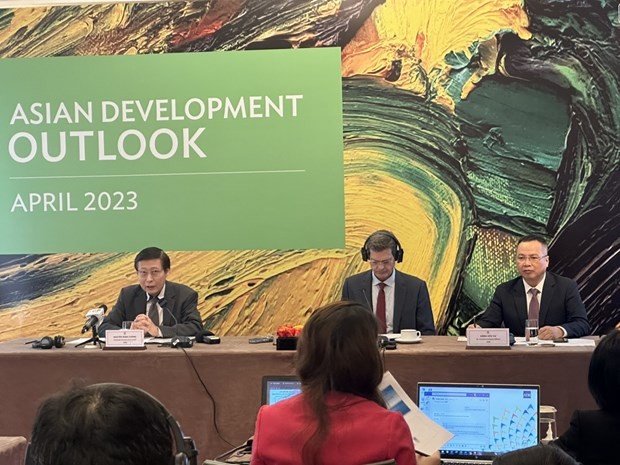 |
| ADB Country Director for Vietnam Andrew Jeffries and leaders at the press conference. Photo: VNA |
After a stellar performance in 2022, Vietnam’s economic growth is projected to ease to 6.5% in 2021 and then further expand to 6.8% in 2024, according to the Asian Development Outlook (ADO) released by the Asian Development Bank (ADB) on April 4.
Vietnam’s economic growth is likely to be hindered in 2023 due to the global economic downturn, ongoing monetary tightening in developed countries, and the consequences of global geopolitical tensions, according to Andrew Jeffries, ADB Country Director for Vietnam.
However, he maintained that Vietnam’s growth-promoting initiatives such as monetary easing, a significant injection of public investment in 2023, and the reopening of the Chinese market will help the country to combat these unfavorable conditions.
The ADO underscored that the worldwide financial downturn had intensified in the fourth quarter of 2022 and was anticipated to persist in 2023. It noted that weakening global demand was anticipated to hamper industrial growth, and also indicated that agricultural output was projected to rise by 3.2% this year, owing to improved domestic demand and the reopening of China, which accounts for a substantial 45% of Vietnam’s exports of fruits and vegetables.
Tourist arrivals from China beginning on March 15 are predicted to bolster tourism and services in Vietnam, with the industry projected to expand by 8.0% in 2021. This influx of visitors will undoubtedly provide a much-needed boost to the Vietnamese economy.
for fiscal year 2023, the slowest rate in the last decade.
The manufacturing Purchasing Managers’ Index (PMI) dropped below 50 for four consecutive months, indicating that export-driven manufacturing had contracted while consumption-led manufacturing was unable to compensate. However, the index showed signs of recovery in February 2023, rising from 46.4 to 51.2. Industry growth is predicted to slow to a decade-low of 7.5% in fiscal year 2023.
Public investment is set to be a major catalyst for economic recovery and growth in 2023 and 2024, driving construction and other related economic activities. In March 2023, when the central bank adopted a policy of monetary easing, increased public spending was expected to create significant multiplier effects, providing a significant impetus for economic growth.
According to the ADO, the Vietnamese government has pledged to disburse a total of USD 30 billion in the year 2023, with 90% of the funds already allocated to disbursing ministries and provinces as of January that year.
Foreign investment, however, will remain hampered by the ongoing global economic slowdown. During the first two months of 2023, newly registered and disbursed FDI decreased by 38% and 4.9% year-on-year, respectively.
The prolonged pandemic has unveiled underlying structural issues that are the primary downside risks to the economy, according to the report.
Nguyen Minh Cuong, the Principal Country Economist for Vietnam, recently stated that the country’s fiscal deficit in 2023 could surpass its target of 4.4% of the Gross Domestic Product (GDP).
He argued that Vietnam should persistently pursue reform in order to establish a more sustainable financial system, drastically diminishing its reliance on unsustainable income sources such as land and oil.
 |
| Central Retail Corporation sees Vietnam as a high-potential market that posted continuous economic growth. Photo: VNA |
The Asian Development Bank (ADB) predicts that domestic consumption will continue to rebound in 2023, thanks to the revival of tourism, new public investment and stimulus programs initiated in January 2022, and a salary increase effective in July 2023. Despite these positive developments, higher inflation could impede the recovery of domestic consumption.
Weakening global demand is set to continue dampening trade in 2023. According to reports, exports in the first two months of that year fell by 10.4% compared to the same period in the preceding year, while imports dropped even further by 16%.
Both imports and exports are expected to decrease by 7% in 2020 and 2021. This slowdown in trade could lead to a current account deficit that is equivalent to 1% of the GDP this year, before returning to a surplus in 2024.
The report also highlighted that surprise policy rate cuts make Vietnam the first economy in Southeast Asia to ease monetary policy, with both monetary and fiscal measures continuing to provide support to the economy going forward.
As of February 2023, Vietnam had attracted close to USD 440 billion from 141 countries and territories around the world.
According to a report released by the Organisation for Economic Co-operation and Development (OECD), Vietnam’s economy is projected to grow by 6.6% in 2021 and is expected to maintain a similar rate of growth over the next three years.
The report states that Vietnam’s economic growth is propelled by foreign investment in the manufacturing sector, particularly electronics, machine manufacturing, textiles, and footwear, and is bolstered by China’s relaxation of Covid-19 prevention and control measures.
At this rate, the Organisation for Economic Co-operation and Development (OECD) has projected that Vietnam will remain the largest economy in Southeast Asia for the top five economies in the region.








